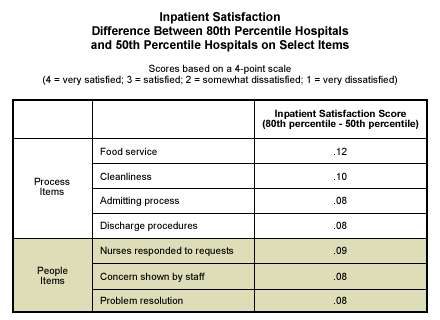In 2002, total annual healthcare spending in the United States reached nearly $1.6 trillion, according to the Centers for Medicare and Medicaid Services. This equals roughly $5,440 per person, 31% of which was spent on hospital care. Inpatient care is clearly big business in the United States, and patients want value for their money. Examining the differences between average hospitals and "best-practice" hospitals using patient satisfaction information from ║┌┴╧═Ї's 2003 healthcare database provides some insight into what hospitals can do to maximize the value that their patients receive.
A comparison of inpatient facilities in the 50th percentile of the ║┌┴╧═Ї database with those in the 80th percentile turns up seven question items that vary most between the two groups. Four of the items (food service, cleanliness, admitting process, and discharge procedures) are "process" items -- that is, they relate primarily to operations rather than human interaction. Three (nurses responding to requests, concern shown by staff, and problem resolution) are "people" items -- that is, they relate primarily to human interaction.

People Items
All three of the "people" items listed show strong relationships with inpatients' overall satisfaction with the facility (correlation coefficients for each are 0.5 or more). Two of the items -- concern shown by staff and nurses responding to requests -- are among the four inpatient items that impact patient satisfaction most.
The fact that these items differentiate highly rated inpatient facilities suggests that quality inpatient providers have employees who are intensely focused on being there when their patients need something, caring about their patients, and fixing problems when they occur.
Process Items
Unlike the "people" items, none of the "process"-related question items for which scores vary most widely between best-practice and average inpatient facilities are highly related to inpatients' overall satisfaction ratings (each produce correlation coefficients of less than .5). Food service and the admitting process actually show the lowest correlation to overall satisfaction of any of ║┌┴╧═Ї's core inpatient measurement items.
But though these items aren't strong considerations for patients when they rate their overall satisfaction with the facility, admitting, cleanliness, and discharge procedures are still important as core operations processes. That best-practice hospitals differentiate themselves from average hospitals on these items may mean that best-practice facilities have implemented the right mix of process-focused and people-focused quality improvements.
But it is also possible for both best-practice hospitals and average hospitals to place too much focus on these considerations, diverting too many resources away from high-impact areas such as nursing care and problem resolution. Food service, for example, has the lowest mean score of any item in ║┌┴╧═Ї's core inpatient survey -- that may alarm hospital administrators, but the item also shows the lowest correlation to overall patient satisfaction. It is also an area that prompts frequent complaints; therefore hospitals often divert their attention to it, to the detriment of staff issues that will ultimately have more impact on patients' overall experiences.
Bottom Line
The healthcare industry has long been concerned with quality improvement. But in the case of most hospitals, these efforts have traditionally been highly process-focused. Hospitals have exceptionally well-documented policies and procedures, as reflected in the way best-practice hospitals differentiate themselves on the admission and discharge processes, cleanliness, and food service. These areas are familiar territory, and they are easier to deal with than "people" issues. However, improvements made to the human side have the strongest potential to positively influence patients' overall evaluations of healthcare facilities.
The best inpatient providers have employees who do a good job responding to the basic needs and expectations of their patients. Hospitals seeking to improve overall inpatient satisfaction should not be seduced by the "squeaky wheel" issues -- like food service -- that receive frequent patient complaints. There is a need for both process improvement and people improvement, but people should come first.